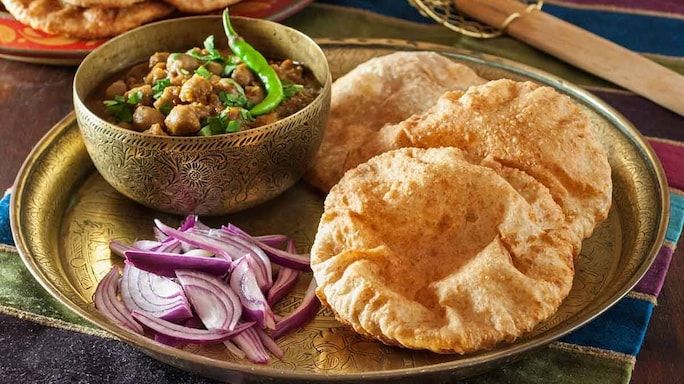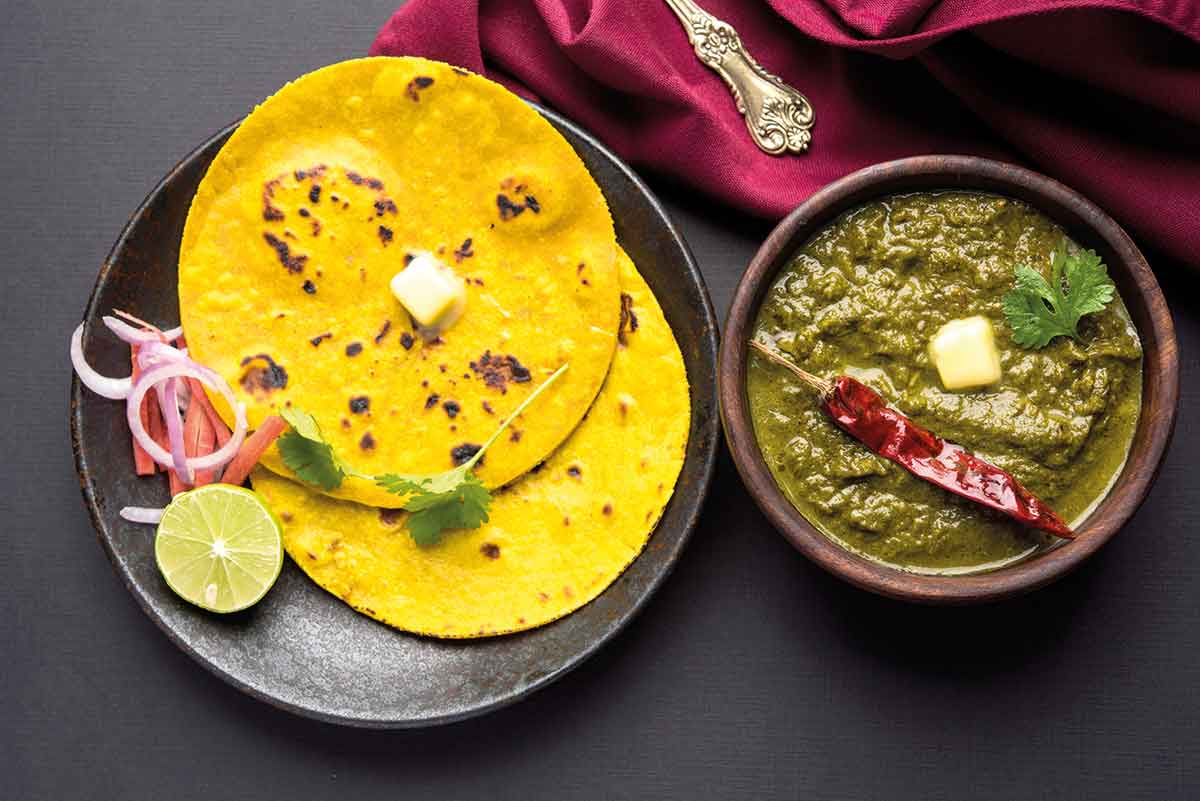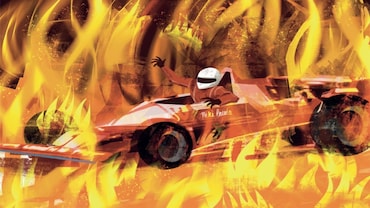- HOME
- /
- Features
- /
- Cover Story
- /
India On A Platter: The Best And Most Popular Dishes From North India
Readers, food experts, historians and chefs curate and select the best dishes from the northern regions of India
 Delhi’s perennial favourite, chhole bhature
Delhi’s perennial favourite, chhole bhature
Delhi
Chhole Bhature: Punjab has a deep relationship with chanak (chana-gram and chickpeas) from the Vedic times. Certain regions in undivided Punjab such as Rawalpindi are proud of their chana with a bite. When refugees from Punjab settled down in Delhi after Partition, they introduced the city to their entrepreneurial ways. And among all they set up in what was a hick town, were little eateries.Some served chhole bhature—puffed, floury, deep-fried breads, presented with a spicy chhole preparation, served with raw onions and green chillies and often a side dish of boiled gooseberries or pickled carrots.
Popular Choice: Chhole Bhature
Haryana
Bajrey ki Khichri: Khichri ke chaar yaar—ghee, papad, dahi, achar. In Haryana, where bajra khichri is a much-loved dish, these accompaniments are a must. In regions not known for cultivating rice, bajra khichri—made with millets—is a speciality. Khichri comes from the Sanskrit khicca, and archaeological evidence suggests that it was consumed in 1200 BC. The grains are cooked until soft, then cumin, asafoetida, turmeric and red chillies are added to hot ghee, and splashed over the khichri. And then, the four yaars are brought to the table. Bliss!
Popular Choice: Bajrey ki Khichri
Himachal Pradesh
Kullu trout: Among the memorable British legacies to India was the trout.The British introduced the fish to what is now Himachal Pradesh in 1909 and because the region’s rivers were so clean and clear, the species proliferated. The river Beas and its tributaries soon became its home. By the early ’40s, trout farms had been set up in Kullu. The trout that you find in Manali restaurants—served steamed, grilled, in gravy or just fried with a dab of butter—is a big draw for tourists.
Popular Choice: Chha Gosht
Jammu and Kashmir
Gushtaba: A Kashmiri-Muslim dish, this is essentially an Indian meatball. Traditionally, lamb meat is beaten with fat, fennel, ginger and coriander, until it is almost white, then shaped into balls and left to simmer in a yogurt sauce. The dish is known as the ‘king of dishes’, which explains why during 21- or 31-course Kashmiri Wazwan feasts, gushtaba is the last dish to be served—to ensure that the taste stays with you, long after the last morsel goes down.
Popular Choice: Rogan Josh
Ladakh
Thukpa: The thukpa—a hearty meal of noodles in a broth filled with vegetables and meat—is believed to have crossed over to India from Tibet centuries ago. When the Dalai Lama fled Chinese-controlled Tibet, he is said to have survived on this filling soup through the long journey to India. This one-bowl meal is especially popular in areas with Tibetan settlements. A good bowl of thukpa once included yak meat, but now mostly comprises minced mutton, ginger, garlic and cabbage leaves. People put in whatever is available to their thukpa cauldron—and every ingredient adds to the taste.
Popular Choice: Thukpa
Punjab
Makke ki Roti and Sarson ka Saag: This leafy mash was first mentioned in the holy texts Acaranga Sutra, and, later, in the Charaka Samhita. The leaves are pulped and cooked with greens such as bathua and palak and a bit of makke ki atta. Once it is cooked, it is lashed with ghee and white butter and eaten with makke ki roti or maize flatbreads. Maize is believed to have reached India after 1492, but a 12th-century temple outside Mysuru shows 92 figures holding something similar to an ear of corn. No matter this mystery, there’s no doubt that Punjab’s much loved saag and roti combo is a winner.
Popular Choice: Makke ki Roti and Sarson ka Saag
 The Punjabi classic, makke ki roti and sarson ka saag
The Punjabi classic, makke ki roti and sarson ka saag
Rajasthan
Dal Baati Churma: Legend has it that Rajput soldiers would bury balls of dough in the sand and set out for battle. When they returned, they found them baked to a golden yellow under the desert sun. The word baati, according to food historian K. T. Achaya, is derived from the Sanskrit word vatya. Baati is a hard, roasted ball of wheat, which is cracked open, doused with ghee and eaten with dal. Churma is a roasted roti that is crumbled, mixed with ghee and sugar, and relished, bit by bit.
Popular Choice: Dal Baati Churma
Uttarakhand
Bal Mithai: It is well documented that this sweet was invented by Joga Lal Sah of Malli Bazar. The roasted khoya pieces are covered with roasted and sugar-coated poppy seeds, which add a nice crunch to the sweet. Bal mithai is made all over the hills now but it’s the exceptional quality of khoya from the villages near Almora that makes the sweet truly special. What made it score over other sweets was its long shelf life. Soldiers returning home could carry it to distant villages and migrant workers in the plains took it along nostalgically.
Popular Choice: Bal Mithai
Uttar Pradesh
Gilawat ke Kebab: Gilawat means tenderizer, so gilawat is the kebab that practically dissolves when you bite into it. Popular lore has it that gilawat had been created especially for an elderly nawab who lost his teeth but not his zest for food. But according to other sources, gilawat ke kebab originated to suit the requirements of elderly pilgrims to a Sufi dargah in Lucknow’s Kakori. Food experts hold that the meat for the gilawat has to be minced and ground 13 times for the right texture. And once done—and eaten—it cannot be forgotten.
Popular Choice: Gilawat ke Kebab
OUR EMINENT JURY PANEL: Food historians: Colleen Taylor Sen, Pushpesh Pant, Salma Husain and Pritha Sen. Restaurateurs and chefs: Manish Mehrotra, Manu Chandra, Zorawar Kalra, Mariyam Kachwala, Regi Mathew, Saby Gorai, Shaun Kenworthy, Thomas Zacharias and Anahita Dhondy. Food writers and critics: Rahul Verma, Prima Kurien, Hoihnu Hauzel and Pawan Soni.






